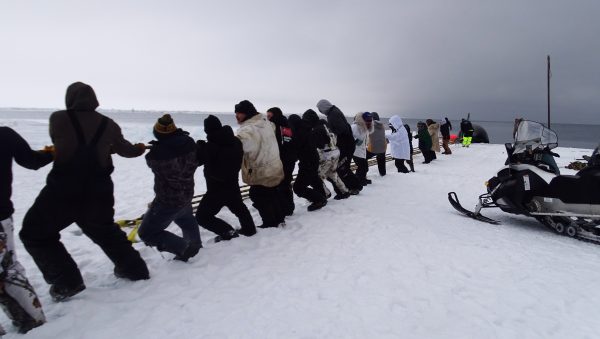Research finds sharing, cooperation key to Arctic villages
November 21, 2016
Debbie Carter
907-474-5406

A new analysis of subsistence data collected in three Arctic communities underscores the importance of social ties and sharing among households.
The analysis draws on data collected in 2009 and 2010, as part of research led University of Alaska Fairbanks Professor Gary Kofinas. The Subsistence Sharing Network Project analyzed the flows of subsistence goods and services among households in Kaktovik, Wainwright and Venetie.
Results from that earlier research found that 60 to 75 percent of the harvesting was the result of household and community cooperation, rather than hunting done by individual households. Hundreds of thousands of pounds of wild foods moved among households in the one-year study period, distributed through sharing, whaling crew shares, community feasts and other social relationships.
Findings highlighted the interconnectedness of the communities, different patterns of sharing for different resources and the sheer magnitude of sharing in the community, said Kofinas.
“Households not only shared within communities, their networks of sharing also extended to other communities across Alaska and to northern Canada,” he said.
Shauna BurnSilver, who worked on the initial study as a postdoctoral researcher, shared the data with a systems modeler at Utah State University and two European mathematicians. Together they applied new analytical methods to evaluate the effects of removing particular households, crews, social connections or resources from the communities’ subsistence systems.
The results of this research were published last week in the Proceedings of the National Academy of Sciences. The analysis found that “the principal challenge to the robustness of such communities is the loss of key households and the erosion of cultural ties linked to sharing and cooperative social relations rather than resource depletion.”
Jim Magdanz, who worked on the original research and is a co-author on the paper, said the results seem intuitively correct. “People matter and social relations matter.”
Anyone familiar with Alaska history can list the many shocks Alaska Native cultures have weathered, he said, including Yankee whaling, gold mining, oil development and population growth. “Yet subsistence harvests remain high, and sharing and cooperation continue to be hallmarks of Native life in Alaska,” Magdanz said.
Kofinas said the findings suggest the need for policymakers and others to support Native villages’ traditional practices of subsistence.
The lead authors are Jacopo Baggio of Utah State University and BurnSilver of Arizona State University. Co-authors include Kofinas of the School of Natural Resources and Extension and the Institute of Arctic Biology; Magdanz, a UAF doctoral student; and Alex Arenas and Manlio De Domenico of the Universitat Rovira I Virgili in Spain.
ADDITIONAL CONTACTS: Gary Kofinas, gpkofinas@alaska.edu, 307-690-5103; Jim Magdanz, jmagdanz@alaska.edu, 907-887-1367; and Shauna BurnSilver, sburnsil@asu.edu, 480-965-8573
NOTE TO EDITORS: Paper available at http://www.pnas.org/content/early/2016/11/14/1604401113.full


